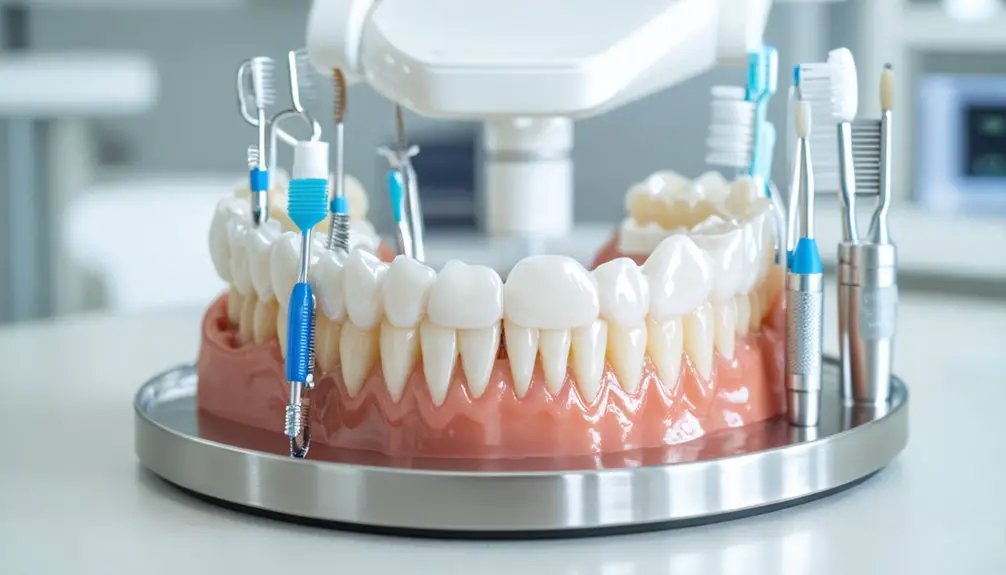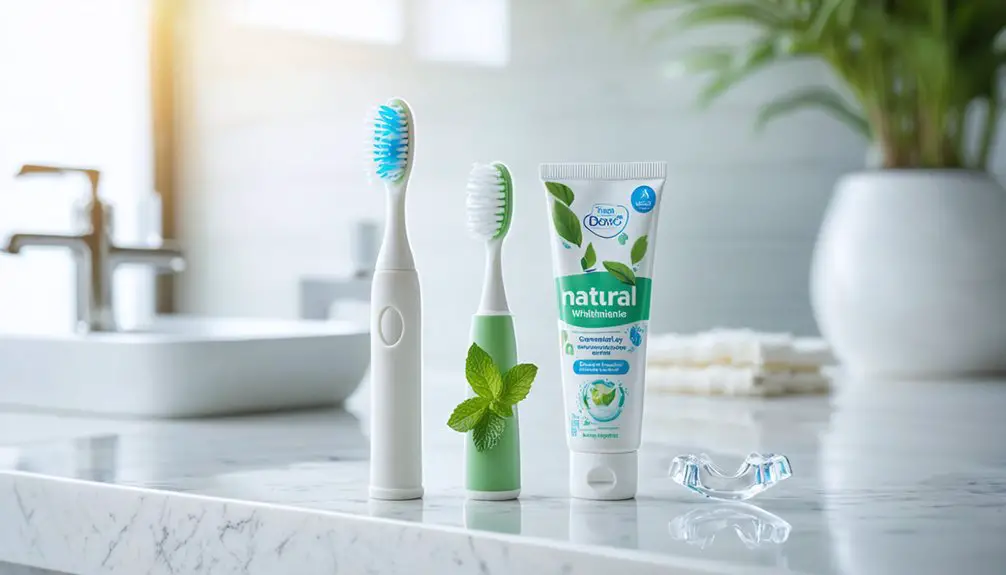While teeth whitening products contain peroxide compounds that generate free radicals, extensive clinical studies involving over 4,000 subjects have found no direct link between whitening treatments and oral cancer. Your body’s natural defenses, including salivary enzymes, help protect against potential toxic effects. You’ll want to use ADA-approved products and follow recommended guidelines for safe, effective results. The science behind these findings reveals important insights about whitening safety.
Key Takeaways
- Clinical studies involving over 4,000 subjects have found no direct link between teeth whitening treatments and oral cancer development.
- While hydrogen peroxide shows genotoxic effects in lab settings, natural salivary enzymes protect oral tissues from potential damage.
- Temporary gum inflammation or tooth sensitivity from whitening agents does not indicate increased cancer risk.
- Research shows no evidence of pre-cancerous or cancerous lesions developing from proper use of whitening products.
- UV light activation in whitening procedures hasn’t demonstrated cancer-promoting effects when used according to professional guidelines.
Understanding the Science Behind Teeth Whitening
While teeth whitening may seem like a simple cosmetic procedure, it relies on sophisticated chemical reactions that target stain molecules embedded within tooth structures.
The oxidation process occurs when peroxide agents, primarily hydrogen peroxide and carbamide peroxide, release oxygen radicals that break down stubborn stain compounds into smaller, less visible particles. These bleaching agents can effectively address both extrinsic and intrinsic stains through targeted oxidation.
When you undergo teeth whitening, these peroxide agents penetrate your tooth’s enamel porosities and dentin tubules, enabling a multidirectional whitening action. Maintaining proper pH balance during treatment helps prevent potential enamel damage and ensures optimal results.
The free radicals interact with double bonds in pigment molecules, effectively dismantling the discoloration from within.
Different whitening methods utilize varying concentrations of these agents – from high-strength in-office treatments to gentler at-home options – but they all function through this fundamental chemical mechanism of oxidation.
The Role of UV Light in Dental Treatments
Beyond the chemical processes of teeth whitening, ultraviolet (UV) light plays a significant role in modern dental treatments. UV applications in dentistry primarily include UV-A and blue-violet wavelengths, which are vital for curing processes and accelerating whitening procedures.
During dental treatments, these lights activate polymerization and generate free radicals that harden composite materials. Research shows that these free radicals can effectively damage oral cancer cells while leaving healthy tissue unaffected.
While UV light can effectively catalyze bleaching agents, it’s important to understand its dual nature. UV exposure can potentially damage oral tissues and induce DNA mutations, particularly in prolonged or improper applications. Professional supervision is crucial for safe and effective whitening treatments.
That’s why many dental professionals now opt for safer alternatives like LED or halogen lights. When UV light is used, precise control over exposure time, wavelength, and dosage becomes essential to minimize risks while maximizing therapeutic benefits in dental procedures.
Research Evidence on Cancer Risk Assessment
Based on extensive laboratory and clinical research spanning decades, the potential carcinogenic risks of teeth whitening products have been thoroughly evaluated through multiple scientific approaches.
While hydrogen peroxide shows genotoxic exposure effects in laboratory studies, your body’s natural defenses prevent significant risks during typical whitening treatments. Modern teeth whitening has been proven generally safe when used correctly.
Clinical evidence from over 4,000 subjects reveals no link between teeth whitening and oral cancer development. Your salivary enzymes efficiently protect oral tissues from hydrogen peroxide’s potential toxic effects. The extensive Journal of Esthetic review validates these safety findings.
Even in high-risk populations like smokers and alcohol users, there’s no indication of carcinogenic effects from whitening treatments. The brief exposure time of 30-60 minutes, combined with rapid breakdown of hydrogen peroxide, guarantees minimal tissue interaction.
Research consistently demonstrates that when used as directed, teeth whitening products pose no significant cancer risk.
Safe Usage Guidelines and Best Practices
Understanding proper usage guidelines assures both the safety and effectiveness of teeth whitening treatments. To ascertain product safety, select treatments approved by the ADA and follow manufacturer instructions precisely. Most whitening agents contain peroxide-based compounds that work to lighten teeth.
Choose ADA-approved teeth whitening products and strictly follow usage instructions to ensure safe, effective treatment results.
Don’t exceed recommended usage frequency of once or twice weekly, as overuse can damage tooth enamel and irritate gums. Professional treatments are performed under careful supervision by a dentist to ensure optimal results.
For sensitivity management, monitor your teeth’s response during treatment. If you experience discomfort, reduce usage frequency or discontinue treatment and consult your dentist.
Maintain thorough oral hygiene throughout the whitening process, and wait at least 30 minutes after treatment before eating or drinking.
If you have dental work, including veneers, implants, or unfilled cavities, obtain professional guidance before starting any whitening regimen. Special considerations apply for pregnancy, gum disease, or existing tooth sensitivity.
Debunking Common Cancer Risk Myths
Despite widespread concerns about teeth whitening and cancer risks, scientific evidence demonstrates no causal link between dental whitening products and oral cancer development.
Myth debunking efforts have revealed that common cancer misconceptions often arise from misinterpreting normal tissue responses to whitening agents.
While hydrogen peroxide and carbamide peroxide can cause temporary inflammation or sensitivity, these effects don’t indicate cancer risk.
Clinical studies show no evidence of preneoplastic or neoplastic lesions from typical whitening product use.
Even UV light activation methods, which raise theoretical concerns, haven’t demonstrated cancer-promoting effects in scientific research.
You’ll find that apparent correlations between whitening and oral cancer often reflect confounding factors like smoking or alcohol use, rather than any direct causation from whitening treatments themselves.
Only a small portion of oral cancer patients used tooth whiteners, with a retrospective study showing just 16 percent of surveyed patients reporting whitener use.
Frequently Asked Questions
Can Teeth Whitening Products Affect Existing Dental Work Like Crowns or Veneers?
You won’t see teeth whitening compatibility with crowns or veneers since these dental restorations don’t respond to bleaching agents. Your natural teeth will whiten, but restorations maintain their original shade.
How Do Teeth Whitening Chemicals Interact With Prescription Medications?
Like a chemical tango, whitening agents can disrupt medication absorption and intensify teeth sensitivity. You’ll need to consult your doctor, as peroxide-based whiteners may interact with cardiovascular and other prescription drugs.
Is Teeth Whitening Safe During Pregnancy or While Breastfeeding?
You shouldn’t undergo teeth whitening during pregnancy or breastfeeding due to safety concerns. While research isn’t definitive, healthcare providers recommend waiting to avoid potential risks from chemical absorption or gum sensitivity.
Does Tooth Whitening Impact the Effectiveness of Oral Cancer Screening Tests?
You can be confident that tooth whitening won’t affect oral cancer screening accuracy. Research shows whitening products don’t interfere with visual examinations or compromise your dentist’s ability to detect suspicious lesions.
Can Professional Teeth Whitening Cause Chemical Burns to Surrounding Facial Tissue?
You’re at risk when peroxide-based whitening agents contact unprotected areas. Chemical exposure can cause burns due to tissue sensitivity, resulting in inflammation, white patches, and ulcerations around your facial tissues.
References
- https://ec.europa.eu/health/ph_risk/committees/04_sccp/docs/sccp_oc01_013b.pdf
- https://www.sciencedaily.com/releases/2004/08/040810093848.htm
- https://pubmed.ncbi.nlm.nih.gov/16198468/
- https://health.clevelandclinic.org/is-teeth-whitening-safe
- https://dentalhealthsociety.com/teeth-whitening/is-there-a-link-between-uv-light-teeth-whitening-and-cancer/
- https://flossdental.com/locations/tx/magnolia/6318-fm-1488/science-behind-teeth-whitening-how-it-works.html
- https://sandlakedental.com/blog/understanding-the-science-behind-teeth-whitening/
- https://pocketdentistry.com/the-science-of-tooth-whitening/
- https://www.champaigndentalgroup.org/about-us/blog-articles/how-teeth-whitening-works-the-science-behind-brighter-smiles
- https://pmc.ncbi.nlm.nih.gov/articles/PMC4058574/



